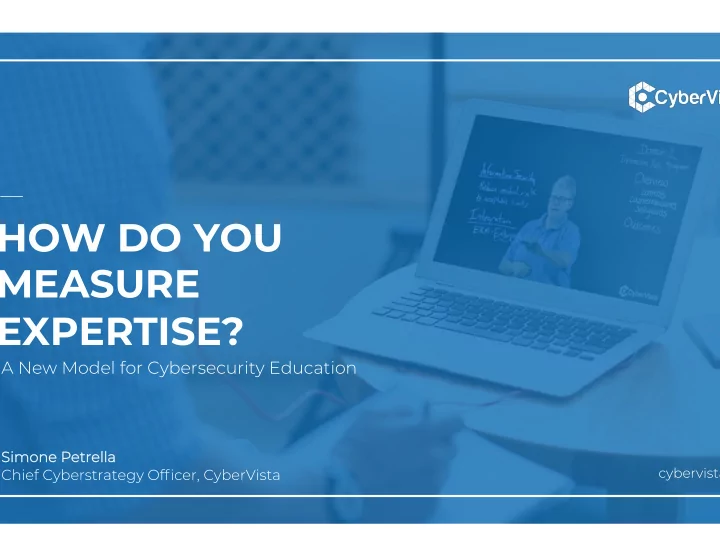

HOW DO YOU MEASURE EXPERTISE? A New Model for Cybersecurity Education Simone Petrella Simone Petrella cybervista.net Chief Cyberstrategy Officer, CyberVista
TODAY’S CYBERSECURITY EDUCATION LANDSCAPE cybervista.net
Current cybersecurity training and education TODAY’S CYBERSECURITY solutions are fragmented, often geared towards LANDSCAPE building a pipeline of candidates, and yet rarely relate skills or competencies to actual job roles. 85 DIFFERENT OVER 260 ABOUT 150 — –– –– Certifications, training courses, and Universities teach cyber Universities teach offensive classes were assessed by CyberVista defense skills cyber skills cybervista.net
THE PROBLEM cybervista.net
A NEW The cybersecurity workforce, including employers and CYBER CAREER MODEL candidates, demands change and requires a new model for developing careers while earning and maintaining skills. This new model must: Distinguish foundational skills from specialized skills § Account for the multi-disciplined (and non-linear) nature § of the profession Prioritize efficient and scalable career-pathing § Assess aptitude and validate abilities § Apply conceptual understanding to practical experience § Focus on critical thinking and ability to learn new skills § cybervista.net
HOW TO GET THERE § Focus on a skills-based approach that addresses employer demand § Start by understanding employer cyber roles and needs § Develop a modular and flexible framework and model focused on skills as they align to specific job roles § Standardize a more structured approach to assessing, learning, and reinforcing cyber skills § Integrate and incorporate both knowledge- based as well as practical hands-on experience cybervista.net
HOW TO GET THERE § Start to move the cybersecurity industry towards professionalization § Distinguish baseline skills of a “cyber professional” versus those indicative of specialization § Create a usable lexicon and framework to identify cyber workforce needs and training requirements cybervista.net
§ Building upon research done by the National Initiative for Cybersecurity Education (NICE) OUR RESEARCH and leveraging the National Cybersecurity PROCESS Workforce Framework (NCWF) , we were able to identify discrete skills needed by employers for job roles at multiple levels and create a roadmap that ties role requirements and skills together. Employer pilots to map Validated Overlaid Prototype cyber common job domains and mapping job JOB ROLE ALIGNMENT workforces roles/related skills with roles to skills by role, skill, skills each role content and level Defined Identified Created common Structured a specific lexicon to core of learning CONTENT topics differentiate DEVELOPMENT domains content covered in levels and across taxonomy each domain proficiencies security roles cybervista.net
CONTENT The first step was to define a common core of cyber TAXONOMY domains, which allowed us to then develop a structured learning taxonomy. Domain Breakdown Governance § Networking § Risk § Security Engineering § Software/Hardware § Threats & Vulnerabilities § Functional Overlay Tools and Techniques § cybervista.net
IDENTIFYING SKILLS PATHWAYS Based on the NIST Cybersecurity Workforce Framework By analyzing the frequency of the requested skills we were able to group them into subsets and identify skills gap between roles cybervista.net
CREATING A TRAINING PATHWAY Once we defined a taxonomy, we were able to apply it to a realistic mapping of job roles and create career pathways that identify the skills gap between different roles and their corresponding levels. cybervista.net
CREATING A TRAINING PATHWAY cybervista.net
Help organizations better define their job roles BALANCING QUALITATIVE AND assess and support the professional development of QUANTITATIVE their staff. MEASURES ASSESSMENTS LEARNING/TRAINING PRACTICE SKILLS –– — — Evaluate new or current Online and modular for re-skilling Online and modular for re-skilling employees on specific skills or up-skilling or up-skilling cybervista.net
Contact:
Recommend
More recommend